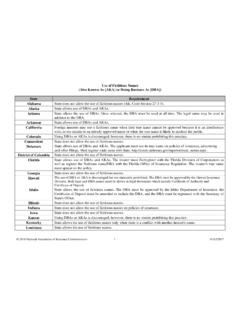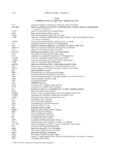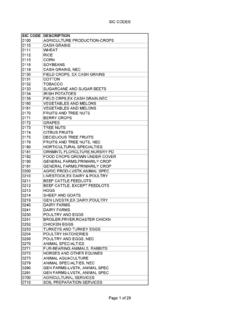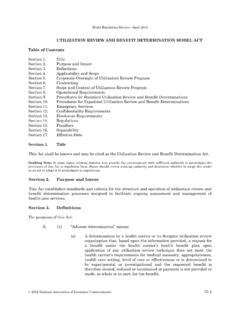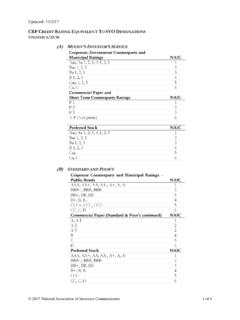Transcription of CUSIP NUMBER - naic.org
1 naic Publicly Traded Securities Listing Definitions CUSIP NUMBER . CUSIP NUMBER Example: 008000AA7. The CUSIP NUMBER is used to identify securities. Every publicly traded security in the Valuation of Securities Database has a unique CUSIP NUMBER . CUSIP numbers are 9 characters long. The first 8 characters of the CUSIP NUMBER uniquely identify a security. The first 6 characters (Issuer NUMBER ) represent the Issuer of a security, the next two characters (Issue NUMBER ) represent the individual issue, and the last character is a check digit. For example 008000AA7 is the full 9 character CUSIP NUMBER 008000 = the issuer ( , ACF Co.). AA = the issue ( Senior note). 7 = Check digit Private Placement NUMBER (PPN). Example: 00800*AA7. A private placement NUMBER is a NUMBER assigned by S&P's CUSIP Service Bureau that is issued for a security that is not traded on the public markets.
2 PPNs can be recognized by the existence of a #, @ or * in the 6th, 7th, or 8th position of the CUSIP NUMBER . If the issuer is a private company, the #, @ or * will appear in the 6th position of the PPN. For privately traded issues of public entities, the #, @, or * will appear in either the 7th or 8th position of the PPN. For example 00800*AA7 is the full 9 character PPN. 00800* = the issuer ( , Private Co.). AA = the issue ( Senior note). 7 = Check digit CINS NUMBER Example: F08000AA7. CUSIP International Numbering System (CINS) numbers are used to identify securities issued in foreign markets. These numbers can be either public or private issues. They can be recognized by the presence of a letter in the first position of the CINS NUMBER . The following letters identify the domiciliary country of the issuer: A = Austria B = Belgium C = Canada D = Germany E = Spain F = France G = United Kingdom H = Switzerland J = Japan K = Denmark L = Luxembourg M = Mid East N = Netherlands P = South America Q = Australia R = Norway S = South Africa T = Italy -1- naic Publicly Traded Securities Listing Definitions U = USA.
3 V = Africa Other X = Europe Other Y = Asia For example F08000AA7 is the full 9 character CINS NUMBER F08000 = the issuer ( , Public French Co.). AA = the issue ( Senior note). 7 = Check digit VOS DESIGNATION. Definition of naic Designation Categories naic Designations are the specific alphanumeric symbols in use by the naic SVO to denote a category of credit quality. When applied to Bonds and to derivative counterparties, the naic . Designation appears without a prefix. The valuation indicator P is placed in front of the naic . Designation to indicate that the SVO has classified the security as a perpetual preferred stock. The valuation indicator RP is placed in front of the naic Designation to indicate that the SVO has classified the security as a redeemable preferred stock for the purposes of valuation under SAP.
4 naic 1 is assigned to obligations exhibiting the highest quality. Credit risk is at its lowest and the issuer's credit profile is stable. This means that interest, principal or both will be paid in accordance with the contractual agreement and that repayment of principal is well protected. An naic 1 obligation should be eligible for the most favorable treatment provided under the naic . Financial Conditions Framework. naic 2 is assigned to obligations of high quality. Credit risk is low but may increase in the intermediate future and the issuer's credit profile are reasonably stable. This means that for the present, the obligation's protective elements suggest a high likelihood that interest, principal or both will be paid in accordance with the contractual agreement, but there are suggestions that an adverse change in circumstances or economic, financial or business conditions will affect the degree of protection and lead to a weakened capacity to pay.
5 An naic 2 obligation should be eligible for relatively favorable treatment under the naic . Financial Conditions Framework. naic 3 is assigned to obligations of medium quality. Credit risk is intermediate and the issuer's credit profile has elements of instability. These obligations exhibit speculative elements. This means that the likelihood that interest, principal or both will be paid in accordance with the contractual agreement is reasonable for the present, but an exposure to an adverse change in circumstances or economic, financial or business conditions would create an uncertainty about the issuer's capacity to make timely payments. An naic 3 obligation should be eligible for less favorable treatment under the naic Financial Conditions Framework. naic 4 is assigned to obligations of low quality.
6 Credit risk is high and the issuer's credit profile is volatile. These obligations are highly speculative, but currently the issuer has the capacity to meet its obligations. This means that the likelihood that interest, principal or both will be paid in accordance with the contractual agreement is low and that an adverse change in circumstances or business, financial or economic conditions would accelerate credit risk, leading to a significant impairment in the issuer's capacity to make timely payments. -2- naic Publicly Traded Securities Listing Definitions An naic 4 obligation should be accorded stringent treatment under the naic Financial Conditions Framework. naic 5 is assigned to obligations of the lowest credit quality, which are not in or near default. Credit risk is at its highest and credit profile is highly volatile, but currently the issuer has the capacity to meet its obligations.
7 This means that the likelihood that interest, principal or both will be paid in accordance with the contractual agreement is significantly impaired given any adverse business, financial or economic conditions. An naic 5 Designation suggests a very high probability of default. An naic 5 obligation should incur more stringent treatment under the naic Financial Conditions Framework. naic 6 is assigned to obligations that are in or near default. This means that payment of interest, principal or both is not being made, or will not be made, in accordance with the contractual agreement. An naic 6 obligation should incur the most severe treatment under the naic . Financial Conditions Framework. naic Designations Related to the Special Reporting Instruction naic 5* is assigned by the SVO to certain obligations when an insurer certifies: (1) that documentation necessary to permit a full credit analysis of a security does not exist and (2) the issuer or obligor is current on all contracted interest and principal payments and (3) the insurer has an actual expectation of ultimate repayment of all contracted interest and principal.
8 This use of an naic 5* Designation is connected with the Special Reporting Instruction contained in Part Two, Section 5(b) of naic Purposes and Procedures manual. The naic 5* Designation is also assigned to certain securities pursuant to policy decisions adopted by the Valuation of Securities Task Force. Securities with naic 5* Designations are deemed to possess the credit characteristics of securities assigned an naic 5 Designation. Therefore a security assigned an naic 5* Designation should incur the same regulatory treatment associated with an naic 5. Designation. The asterisk (*) after the quality indicator 5 distinguishes the naic 5* Designation from the naic 5 Designation that is only assigned by the SVO after a full credit analysis. naic 6* is assigned by an insurer to an obligation in lieu of reporting the obligation with appropriate documentation to the SVO for a full credit analysis or filing the certification required for obtaining an naic 5* Designation.
9 This use of an naic 6* Designation is connected with the Special Reporting Instruction contained in Part Two, Section 5(b) of naic Purposes and Procedures manual An naic 6* Designation is also assigned by the SVO to an obligation that was assigned an naic 5* Designation in a given year if no Subsequent Report is received by the SVO. Securities with naic 6* Designations are deemed to possess the credit characteristics of securities assigned an naic 6 Designation. Therefore a security assigned an naic 6*. Designation should incur the same regulatory treatment associated with an naic 6 Designation. The asterisk (*) after the quality indicator 6 distinguishes the naic 6* Designation from an naic . 6 Designation that is only assigned by the SVO after a full credit analysis.
10 Valuation Indicators Pursuant to Part Three, Section 1(b) of naic Purposes and Procedures manual, SVO is required to classify preferred stock as either perpetual or redeemable. Valuation Indicators show the classification decision of the SVO and are to be used by insurers to determine a SAP valuation method for preferred stock. P means perpetual and is a valuation indicator used to classify a preferred stock as perpetual, pursuant to Part Three, Section 1(b) of naic Purposes and Procedures manual. The valuation indicator P means that the issuer of the preferred stock is not obligated to redeem the issue, the holder of the preferred stock does not have a right to put the preferred stock to the issuer or that -3- naic Publicly Traded Securities Listing Definitions there is no other equivalent right.


